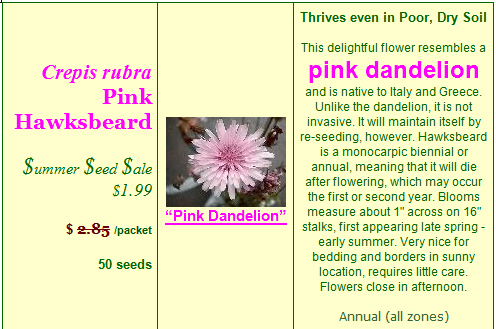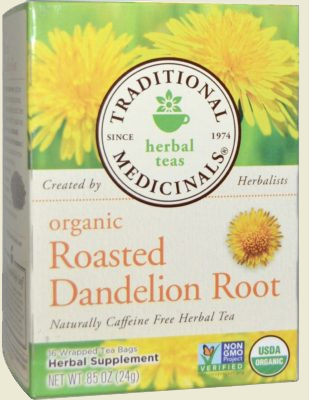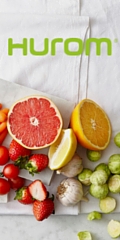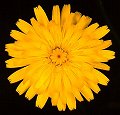“Tickled Pink” to Find a Dandelion
Common activities children like to do with dandelions include plucking a bright yellow blossom and holding it under someone’s chin “to see if they like butter”, and forming a golden crown, necklace, or bracelet by making a cut in one flower stalk and inserting the blossom of different flower stalk into it, one after another.
A folk name for dandelion, yellow gowan (gowan: yellow kind of a common daisy) refers to the blooming dandelion’s bright golden yellow. Is there any other color?
 Click the Pretty Pink to order these dandelion relatives.
Click the Pretty Pink to order these dandelion relatives.




June 4th, 2009 at 8:01 pm
Hello! I stumbled upon your website while doing research. I am currently working on a ten week long funded research project to create a pink dandelion. I found your website very informative and your interest in dandelions absolutely refreshing. I was wondering if you had any ideas regarding my research and maybe if you would be able to point me in the right direction. Thank you!
(Click on Nicole’s name above to go to her website)
June 4th, 2009 at 10:56 pm
Hi, Nicole,
Thank you for your kind words! I’m so glad to hear from you. I’ve never heard of a totally pink dandelion (like everybody else) and would be honored to be included in the first to know should you succeed!
Using the root—or whole dandelion plant—can yield an ardent shade of magenta dye when using alum as a mordant. And the crown, between the leaves and the root, and veins are often tinged pink.
You may be able to tweak some pink blossom color from certain carotenoids (a class of yellow to red pigments, including the carotenes and the xanthophylls) that are present in dandelion, some of which are:
• chrysanthemaxanthin
• cryptoxanthin (a provitamin A carotenoid)
• violaxanthin
• carotenes (tetraterpenes, derived from isoprene): beta carotene [an antioxidant; the body converts this pigment, an isomeric form of carotene, to vitamin A. The dandelion leaf is one of the richest natural sources of beta-carotene, 20 percent more than carrots.]
• xanthophylls (those “happy”, “healing” colors): fat-soluble antioxidant carotenoid biochemical pigments that, along with lutein, disinfect your lungs and deter the presence of bacilli.
• lutein (yellow carotenoid pigment) promotes eye health, sharpens vision, wards off macular degeneration (a condition that can cause blindness), protects specifically against breast and ovarian cancer.
• zeaxanthin (with lutein, the only carotenoids found in the retina and lens of the eye.)
An interesting angle might be to find out what it is that gives some dandelion relatives their pink blossoms:
cultivated specimens like…
• pink-blooming artichokes (Cynara scolymus), and
• dinner-plate sized pink-blooming dahlias
and weeds like…
• pink-blooming asters
• pink-blooming (bull, and St. Mary’s milk) thistles
• Eupatorium (pink-blooming Queen-of-the-Meadow or Joe-Pye-Weed, Hemp-agrimony, etc.)
• pinkish-purplish Ironweed (Vernonia fasciculate)
• pink-blooming Pertya scandens (Pertyoideae), and
• pink-blooming yarrow (Achillea millefolium).
What it is that makes blooms pink, can that pink color be induced in other members of the sunflower family—like dandelions? I remember the big prize to the first one to develop a black rose, or a true blue.
Responding to looking at your website—and I love your website!—I bought $50 worth of dandelion seed, planted them, and the deer and rabbits ate them! (We live next to a greenway.) I did not get to harvest any!
I hope my response is helpful to you. We are “tickled pink” you wrote us!
Sincerely yours,
Ruth
June 8th, 2009 at 6:04 pm
Hi Ruth
I appreciate so much you getting back to me so quickly! I am thrilled with all of the information that you sent my way… it will definitely help me!
This week I’m making dandelion tea for those that are coming into the Crane, which is where I am growing dandelions indoors. I’ve found a fair amount recipes… so now it’s just a matter of finding my favorite!
Can I ask what got you so interested in dandelions and prompted you to make such a wonderful and informative website?
Of course you can post anything about my project and blog on your website! I only ask that perhaps I could quote you and your website as a source and maybe put a link or two to your website from my blog?
I look forward to hearing back from you! And I hope you are doing well!
Sincerely,
Nicole
(Click on Nicole’s name above to go to her website)
June 8th, 2009 at 11:27 pm
Great to hear from you! Ooohh, I wish I could join you for Dandelion Tea!!
Would it be easier to make a pink dandelion blossom from a white one? Yellow flower pigment quantity varies greatly with different kinds of plants; however, if the yellow vanishes, we get a white flower.
I’m not sure when I became so interested in dandelions…a LONG time ago, and I’ve eaten them since childhood. Glad you like the website! I would be honored for you to quote me and/or the website and for any links from your blog! Thank you!
I’m eager to follow your progress on your website! Ground-breaking! Amazing! I am well and hope you are, too!
Ruth
June 11th, 2009 at 1:22 pm
Hi Ruth
No I haven’t seen this but it is really useful… thank you! Your enthusiasm with my project is really motivating and I really appreciate all of your input.
Right now I’m thinking that dyes are my best bet…
I hope that things are going well with you!
Sincerely,
Nicole
June 11th, 2009 at 1:23 pm
Hi, Nicole!
Some edible decoration ideas for your Tea Party, if you would like to try and see if any of them will tint dandelion blossoms pink (note how a cut dandelion stem will curl up!):
Pick dandelion blossoms and put them in vases with different acid, base, & neutral room-temperature solutions, e.g., shredded red cabbage juice—raw, cooked, plain, & with a drop of lemon juice; beet juice—raw, pickled…
Just an idea … Have you thought of using dandelion dye, to dye dandelions? That is, use the whole plant to get a magenta color, then pick fresh blossoms and set them in a vase to see if the dye will soak up into the flowers?
(If you can’t beat ’em, join ’em!) Have fun!!!
Ruth
June 11th, 2009 at 2:19 pm
Hi Ruth
I think that “tickled pink” is perfect! And I am really excited about you putting my project onto your website. It truly looks great.
I will try your suggestions! Again, thanks for all your input!
Sincerely,
Nicole
June 12th, 2009 at 1:21 pm
Hi, Nicole,
Continuing the vein of what I wrote you on using juice from red cabbage, that by adding an acid (lemon juice or vinegar), the color of the juice changes from blue (think of chicory, a dandelion relative) to pink.
Tangent to the chemistry of changing a blossom color into pink (or visa versa), a somewhat similar principal works in growing hydrangea plants, simply by altering the pH of the soil. Neutral to alkaline soils with pH 6.5 or higher produce pink flowers, blue flowers bloom in acidic soil of pH 5.5 or lower, and soil with pH between 5.5 and 6.5 produce purple flowers or a mixture of blue and pink flowers in the same plant.
Consider that it is much easier to change a hydrangea pink to blue (adding aluminum, copper, or zinc to the plant soil in a water solution throughout the growing season, taking care not to burn the roots) than blue to pink (the reverse, i.e. subtracting aluminum, copper, or zinc from the soil); one cannot change a white hydrangea at all. To ensure that the minerals are made available to the plant, it is important to note the pH level of the soil; for hydrangeas, the lower the pH, the bluer the flowers. Plants grown in soil with a pH over 7 may need to have iron added in some dosage as well.
The solution to pink blossoms may be in watering the plants! Just maybe?
Iron nails, and aluminum, copper, or zinc placed on three sides of a hydrangea plant will give three different colored blooms in one plant. Aluminum indeed does change hydrangea blossom color; however, adding the toxic aluminum produces blue—not pink—and, dandelion is an EDIBLE plant. Nicole, I’m so thankful that you want to go in a positively PINK direction! 100g (3.5 oz) of raw dandelion leaves contain .171 mg copper, 3.1 mg iron, and 0.41 mg zinc; the more, the merrier?
Copper acts as a catalyst in the formation of hemoglobin; the copper-binding protein, ceruloplasmin, plays a major role to distribute iron throughout the body, especially to the brain. (People with dementia have inadequate ceruloplasmin levels.) Dandelion is a rich source of iron, a mineral essential for life. Zinc is a trace mineral required by over 100 enzymes that make DNA for cell replacement and protein synthesis from amino acids. A human body needs zinc to maintain proper levels of vitamin C; dandelions help supply this important element.
Your BIG Dandelion Tea Party is tomorrow!!! Everybody, have lots of fun! (When’s your NEXT Dandelion Tea Party???)
Sincerely yours,
Ruth
January 20th, 2011 at 7:08 am
Do you know where you can find/purchase raw dandelion root and burdock root that have NOT been roasted or processed. I have read that processing ruins healing properties in the plants. I would also prefer to stay away from herbs processed in China due to conflicting reports about safety. Please advise. Thank you.
Tim
January 21st, 2011 at 11:42 am
Hi, Tim! Great to hear from you–great question! And one I am personally interested in! I have been checking into it since yesterday (before and after teaching German). So far I have found out that as “most people” are not interested in unroasted/unprocessed, it is therefore not as profitable for companies to sell it that way. I will continue checking and look forward to answering you soon–I want to locate good sources that offer the root raw!
In the meantime, does anyone “out there” know?
I have an unlimited backyard supply I like to dig up for myself. Ruth